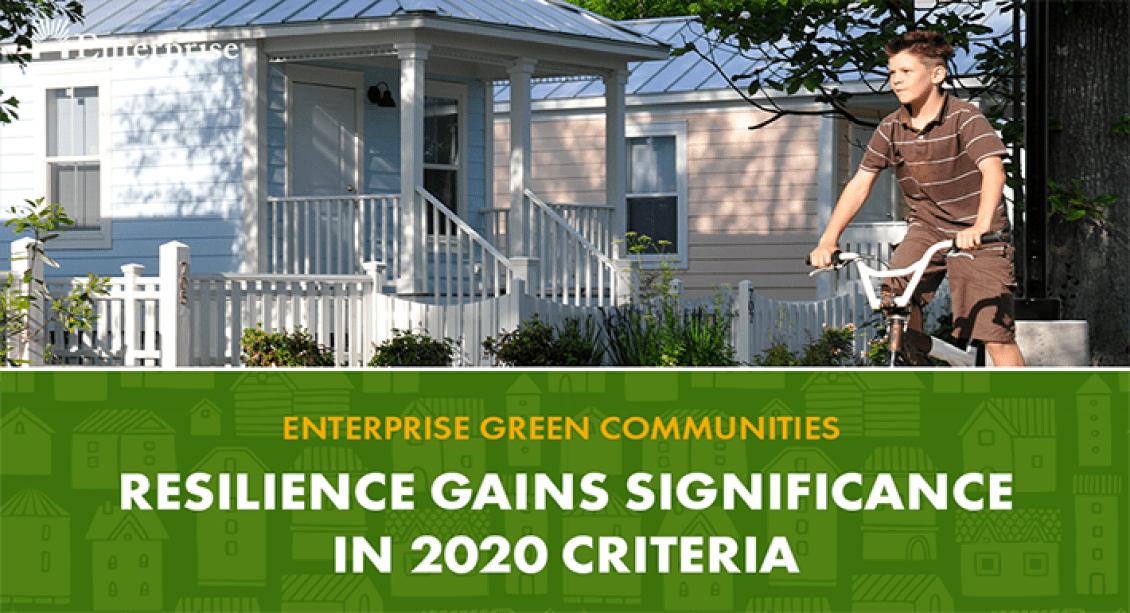This blog is part of a series exploring themes critical to affordable housing development and central to the 2020 Enterprise Green Communities Criteria: integrative design, path to zero energy, healthy housing and water.
2020 hasn’t pulled any punches, bringing a steady series of destructive weather events and an unprecedented global pandemic. It’s forced us to reconsider how we respond during a natural disaster and essentially redefined what “sheltering in place” means.
Originally, sheltering in place was thought to mean seeking safety in a place you’re already occupying for a period of minutes or perhaps a day. Now that we’ve been asked to take shelter for months, it’s clear that the places where we live need to do more than help protect us from storms and fires. They need to be resilient enough to meet the everchanging needs of our society.
This extended time at home has shifted our expectations of how housing keeps us safe and healthy. Now more than ever, our homes must provide a stable place to live no matter what’s happening or changing outside in the world around us. Housing that incorporates resilient features helps ensure that we can thrive in the face of what’s happening outside our walls.
Affordable housing developers are in a unique position because of their commitment to ensuring the housing they create or preserve remains viable. By identifying potential risks and mitigating the long-term effects of our changing climate, developers can protect residents against natural disasters facing the surrounding community.
“All families deserve well-built homes they can afford, as well as the peace of mind that comes with knowing that their home can survive a natural disaster without bankrupting them.”
― Marion Mollegen McFadden, Enterprise SVP, Public Policy, Senior Advisor, Resilience, testifying before the U.S. House Select Committee on the Climate Crisis
Enterprise believes resilience, whether against a storm event or a global pandemic, isn’t just about being able to bounce back or rebuild – it’s about drawing from the inherent strength in communities and helping everyone prepare for and move forward in the face of our new future. And when we build more resilient communities, we build a better, more equitable future for everyone.
Resilience: What’s New in the 2020 Criteria?
The latest version 2020 Green Communities Criteria has refined the resilience strategies that were introduced in the previous version of the criteria, and places them front and center to ensure homes are habitable for residents during and after a disaster. All projects, whether new construction or rehabilitation, will complete a Climate and Environmental Resilience Assessment within the Project Priorities Survey. The assessment will walk project teams through a process to:
- Identify and prioritize site hazards using nationally available data or appropriate local data
- Determine potential risks associated with each hazard
- Collaborate with the project team to prioritize identified hazards based on resident population, building type and location
By completing the assessment, project teams will have a road map for discussing resilience throughout the development phase.
We’re also lifting up strategies for project teams to recognize and cultivate both residents’ and communities’ inherent resilience. Criterion 1.7, Strengthening Cultural Resilience, is a new optional criterion that honors cultural identities, resident voices and community histories – bringing residents’ and the community’s needs and contributions into sharp focus. Projects that incorporate this criterion will benefit from an increased sense of shared ownership over public spaces, promote social accountability for upkeep and safety, and deepen residents’ sense of belonging.
Resilience: An Inherent Strategy in the 2020 Criteria
Some individual criteria, like the Emergency Management Manual, explicitly address resilience. It’s also important to recognize that resilience is an overarching theme evident throughout the 2020 criteria. Each criteria category, like Operating Energy, for example, addresses a specific and straightforward topic that may seem unrelated to resiliency. However, the results of implementing criteria within the Operating Energy category provide a multitude of benefits, including creating a more resilient building that will respond better to power outages.
Another example is in the Location + Neighborhood Fabric category, where project teams ensure that their project is not located on sensitive lands. At first glance, it may appear that the standard is solely intended to protect the environment; however, it also protects projects from potential flooding.
The criteria are designed to provide universal guidance for resilience strategies that protect people and property in regions across the country. Teams can augment the standards with more specific design and construction approaches that respond to their local conditions, including hurricane-force winds, wildfires and stormwater runoff.
The 2020 criteria now has a clear path for building a zero-energy building. In addition to creating resilient buildings, moving to zero energy serves several purposes. It also provides affordable housing developers a way to significantly lower their energy costs and meet state or local jurisdiction climate action plans. A zero-energy building can potentially provide needed power during an electricity outage. Plus, it’s better insulated than traditional buildings, and will retain comfortable temperatures with less energy for a longer period of time.
Resources
Whether a team is new to Enterprise Green Communities or has several certified projects in its portfolio, the criteria recommend key resources and tools to help meet resilience-related requirements:
- The Federal Emergency Management Agency’s (FEMA’s) hazard mitigation planning resources include handbooks geared toward state, local and tribal governments; guidelines for sustainability in mitigation planning, Planning Advisory Service Reports, and examples of mitigation activities.
- FEMA’s Building Vulnerability Assessment Checklist may be used as a screening tool for preliminary design phase’s vulnerability assessment.
- The Enterprise Green Communities Ready to Respond Toolkit helps project teams complete Criterion 1.6, and provides further guidance on developing comprehensive plans to prevent displacement, protect buildings and engage residents on disaster preparedness.
- Resources for Criterion 1.7, Cultural Resilience, can be found under Templates for Certification on the Enterprise Green Communities website.
- The Seattle Office of Emergency Management provides many valuable resources, including a Resident Disaster Recovery Booklet translated into several languages.
